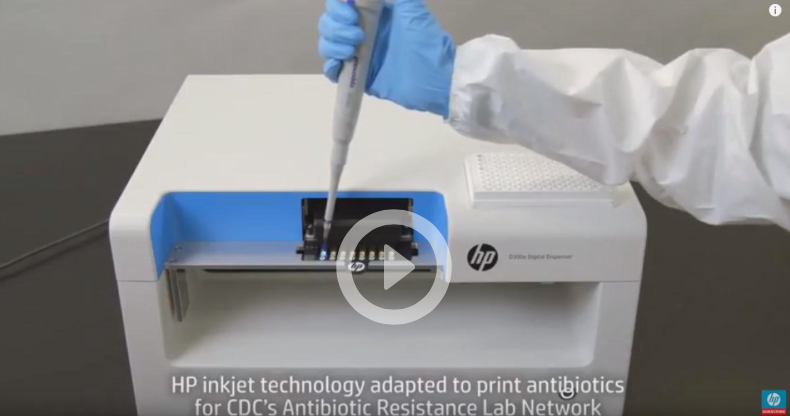 CDC purchases HP D300e Digital Dispenser BioPrinters for Antibiotic Resistance Lab Network to accelerate testing of new antibiotics
CDC purchases HP D300e Digital Dispenser BioPrinters for Antibiotic Resistance Lab Network to accelerate testing of new antibiotics
• CDC launches HP pilot program with the purchase of HP BioPrinters for four regional labs in New York, Minnesota, Tennessee, and Wisconsin.
• HP BioPrinters, with inkjet printing technology, adapted for automated laboratory dispensing to help fight antimicrobial resistance.
• Makes testing of new antibiotics possible at the local level for the first time
Today HP Inc. announced its participation in a pilot program run by the Centers for Disease Control and Prevention (CDC) that aims to accelerate the testing of new antibiotics designed to fight antimicrobial resistant bacteria. The pilot uses HP technology to “print” pharmaceutical samples. As part of the pilot, CDC will deploy new HP D300e Digital Dispenser BioPrinters to four regional labs in the Antibiotic Resistance (AR) Lab Network, to develop antimicrobial susceptibility test methods for new drugs. For the first time, regional labs will be able to conduct rapid susceptibility testing for health departments and hospitals nationwide.
“Bacteria continuously develop new ways to resist antibiotics—once a drug is approved for use, the countdown begins until resistance emerges. In fact, resistance has even been detected before FDA approval,” said Jean Patel, PH.D. D (ABMM), Science Team Lead, Antibiotic Resistance Coordination and Strategy Unit at CDC. “To save lives and protect people, it is vital to make technology accessible to hospital labs nationwide. We hope this pilot will help ensure our newest drugs last longer and put gold-standard lab results in healthcare providers’ hands faster.”
Antimicrobial resistance is an international public health issue. New antibiotics for resistant bacteria can help save lives, but hospitals often do not have access to antimicrobial susceptibility testing to know if the new drug might be effective. The HP printer helps to speed up testing availability at the local level by “printing” the gold standard test plates in a few minutes. When testing is not available, new drugs can be either overutilized, contributing to antimicrobial resistance, underutilized, not helping patients in need, or misutilized, which can lead to side effects or prolonged treatment.
How it Works
The BioPrinter accurately dispenses or “prints” volumes from picoliters to microliters for faster, more reliable dispensing of small molecules and biomolecules to enable drug discovery, genomics, and proteomics research. The following labs within the AR Lab Network will use this technology to develop and perform antimicrobial susceptibility testing for new drugs: New York, Minnesota, Tennessee and Wisconsin. This new capacity can be used by healthcare providers for patient care while commercial methods commonly used in hospital laboratories are developed and implemented.
Testing through CDC will be implemented in the regional laboratories in the first quarter of FY19. CDC will prioritize testing for highly resistant bacteria, with pan-resistant bacteria being the top priority. HP will coordinate with CDC to evaluate the pilot in the regional laboratories of the AR Regional Lab Network, refine the system, and explore and support a larger rollout of inkjet printing technology in labs nationwide.
www.hp.com


















































































